Early Signs: Water Disappearing
Air Date: Week of April 14, 2006
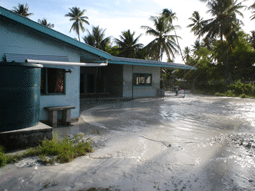
Flooding in South Tarawa, Republic of Kiribati (Photo: Alice Leney)
For low-lying coral islands in the South Pacific, the warming of the planet and its atmosphere is not an abstraction, it's a reality. In the fifth in a series on early signs of climate change around the globe, Aaron Selverston reports from the island nation of Kiribati (kiri-bahs).
Transcript
CURWOOD: Throughout the Pacific Ocean, tropical islands are feeling the early effects of global warming. Located halfway between Hawaii and Australia, the Republic of Kiribati, home to 100,000 people, is one such place, and it’s the focus of this week’s installment in our series "Early Signs: Reports from a Warming Planet."
The series is a collaboration of the UC-Berkeley Graduate School of Journalism, Salon dot com, and Living on Earth to document places around the world where concerns about climate change are already having an impact. Aaron Selverston takes us to Kiribati, a small nation of palms trees, coconuts, and canoes, for a view of life from just six feet above sea level.

Flooding in South Tarawa, Republic of Kiribati (Photo: Alice Leney)
SELVERSTON: From 10,000 feet above the Pacific Ocean, the tropical island of Tarawa resembles the vanishing stage of a waning moon – a razor thin crescent of shimmering green against a vastness of dark ocean, its very existence seems accidental, precarious, as if a single thunderhead could wash it away.
[INSIDE PROP AIRPLANE]
SELVERSTON: Dropping to 1,000 feet, detail of a coconut grove emerges, a carpet of thick, green fans swaying against the wind. On the inside edge of the crescent, a sliver of white sand contains a luminescent lagoon which blends from bright teal along the shoreline to dark turquoise in the center.
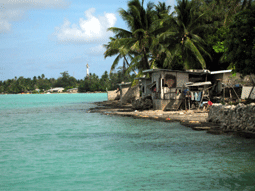
The islands of the Republic of Kiribati average only six feet above sea level. Here, Tarawa's lagoon comes right up to a residence. (Photo: Oskar Garcia)
SELVERSTON: At 500 feet, closing in on the beach, a collection of thatch-hut dwellings appears near the shore.
[WALKING ON BEACH]
SELVERSTON: Down on the sand, a man is walking, contemplating how the shoreline has changed in the thirty years since he last came to this spot: the site of his childhood home. He stops in front of two cement blocks poking out of the sand.
MacKENZIE: Yeah, this is the foundation of the house I grew up in.
SELVERSTON: Uentabo MacKenzie.
[MORE SANDY FOOTSTEPS]
MacKENZIE: That used to be my playground. I remember playing soccer between the house and the trees way back there.
SELVERSTON: MacKenzie, an expert on the South Pacific who authored a World Bank report on the social impacts of climate change, says people all across this island nation, the Republic of Kiribati, are complaining of erosion.
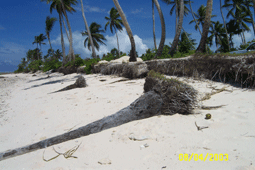
A fallen coconut palm tree waits to be washed out to sea. Erosion in Bonriki, Republic of Kiribati, is pushing the shoreline back. (Photo: Republic of Kiribati Ministry of Environment, Lands, and Agricultural Development)
SELVERSTON: He points out to where the waves are crashing.
MacKENZIE: There used to be coconut right up to there, and big trees even further back than where the water is now. A lot of land has been eroded away. A good fifty meters – fifty, sixty meters – is now under water. So I feel sad coming back to my old playground.
SELVERSTON: More of these difficult changes are likely for I-Kiribati, as people here call themselves. Climate scientists say coral atoll islands throughout the South Pacific could be the most susceptible areas in the world to the effects of global warming.
The Intergovernmental Panel on Climate Change, a U.N.-sponsored group representing the scientific consensus on climate change, says that rising sea levels could cause not just erosion, but flooding and salinization of soils and freshwater.
I-Kiribati from across the islands are already complaining of these problems. MacKenzie, who directs the Kiribati branch of the University of the South Pacific, says that there is little that can be done to stop his nation from getting washed away.
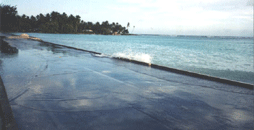
High tide splashing over Taborio causeway, South Tarawa, Republic of Kiribati (Joseph Keyerleber)
MacKENZIE: I think when we look at the changes that are happening in Kiribati, I think it’s a combination of both things: man-made developments and climate change.
SELVERSTON: Climate change could exacerbate these problems.
MacKENZIE: I have no doubt that these islands will be inundated. Or, if they’re not inundated, the livelihood of people will be very difficult, because it will affect saltwater incursion into our water tables, it will affect our plant-life, it will affect the water we drink.
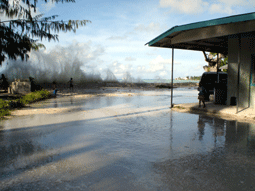
Wave crashing over sandbags on South Tarawa, Republic of Kiribati. (Photo: Alice Leney)
[SOUND OF POURING WATER INTO A SAMPLE JAR, SCREWING THE LID SHUT]
SELVERSTON: In a laboratory in Tarawa’s department of public works, Natasha Kuruppu, an Oxford grad student studying climate change and freshwater supplies, pours a sample she collected from a local well into a beaker.
KURUPPU: People will get sick if saltwater keeps intruding into their freshwater, because you can’t drink it, it’s too salty. And then your internal organs won’t function properly. So we need to protect our freshwater lenses from getting saltwater contamination.
SELVERSTON: Freshwater lenses are cone-shaped bodies of water that literally float on top of denser ocean saltwater. These lenses, which contain the only freshwater in Kiribati other than rainwater tanks, are especially vulnerable to sea level rise. Every inch the ocean comes up pushes a freshwater lens 40 inches closer to the surface, until it disappears entirely. With sea levels expected to rise up to two and a half feet or more in the next century, Kiribati must face losing its main freshwater supply, which could be catastrophic.
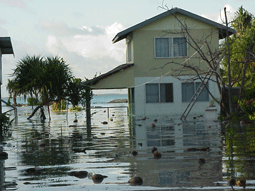
Flooding at the Lagoon Breeze Hotel, South Tarawa, Republic of Kiribati (Photo: Republic of Kiribati Ministry of Environment, Lands, and Agricultural Development)
[INSIDE PROP AIRPLANE]
SELVERSTON: Air Kiribati, the official airline here, is the best way to get to and from the 32 outer islands. Abemama atoll is thirty minutes south of Tarawa by plane. With a population of 4,000, it is far more pristine than the overcrowded Tarawa, which has nearly half of Kiribati’s entire population of 100,000.
[CHORAL MUSIC]
SELVERSTON: On Abemama, a church group is practicing for a singing competition inside a maneaba, a thatch-roofed dwelling common throughout Kiribati. The maneaba is the center of village life, a gathering place for parties, ceremonies, and important decision-making.
[CHORAL MUSIC]
SELVERSTON: As a community elder, Mikaio Rorubuaka sometimes leads songs like these. He sits atop a stone sea wall he built to keep his land from being flooded. He’s noticed that many of his neighbors don’t worry about global warming, because they have faith in God. Their reference point is the biblical flood.
RORUBUAKA: They believe in what the Bible says. During the time of Noah, there was a flood, and the Ark was built to save good people – Noah’s family, animals – but when the flood stopped, God made a promise to Noah not to make any more floods to happen.
SELVERSTON: Mikaio is referring to Genesis 9, in which God tells Noah: “I will establish my covenant with you; neither shall there any more be a flood to destroy the earth.
Next, God tells Noah that a rainbow will always be a sign of this promise. Mikaio says nowadays, when it rains, some people look to the sky for that reassurance.
RORUBUAKA: A rainbow is a sign they always see when it’s raining, and it reminds them whenever they see it in the sky. It’s a symbol, a sign of God’s promise that there won’t be anymore flood.
SELVERSTON: Though Mikaio considers himself Christian, he does not feel that same sense of comfort.
RORUBUAKA: With climatic change, and the effect of the greenhouse, we cannot survive. The islands, particularly the islands in Kiribati, which are very low, will be submerged. And then where would the people be then?
SELVERSTON: Because he's an elder, or “unimane,” Mikaio is also an advisor in his community. He’s carefully considered the role religion plays in people’s views on global warming, and offers this advice to those who remain unconcerned:
RORUBUAKA: You’ve been given your mind by God to use and think about it. So that’s what I’m going to advise, that they should use their mind and think besides believing that nothing is going to happen because God is looking after them.
SELVERSTON: Down the street from the manaeba, nestled amongst a grove of tall coconut palms, Tam Tamere returns home after an unsuccessful fishing trip. For Tam, some disturbing changes have already arrived. He’s noticed a distinct drop in the quantity of tuna – a problem the World Bank says will likely grow worse throughout Kiribati with global warming.
But Tam’s frustrations don’t end there. He can no longer drink the water under his own land. It’s become too salty. And now, even his coconut trees are being affected.
TAMERE: When the place gets salty water, then the coconuts are getting smaller. The water is not so good, and the tree not produce a very big fruit.
SELVERSTON: Tam also says he has witnessed the sea level coming up and has considered the potential long-term result:
TAMERE: We might live like fish, you know, but we pray hard not to live like that.
SELVERSTON: Kiribati President Anote Tong devotes an increasing share of his time to these issues. I caught up with him at Tarawa’s airport, on his way back from the outer island of Butaritari, people there complained to him that taro pits have become flooded with saltwater. Taro is a root crop and staple food in the South Pacific.
TONG: It’s seriously a matter of survival.
SELVERSTON: Tong says that many of his domestic priorities, like economic development, are being sidelined.
TONG: We really cannot discuss issues of development if in the longer term we are facing an issue of survival. So no matter how much we develop in the next decades, if in fifty years time we’re going to go under, what is the purpose of it all?
SELVERSTON: But is it really too late to save the islands? Can’t Kiribati try to adapt in some way?
TONG: We can only adapt so far. For countries like Kiribati is that we may have already gone well beyond adaptation. Maybe we’ve reached the stage where very little can be done now to reverse the process.
SELVERSTON: A study of glacial melt published in the journal Science in February found that Greenland’s glaciers are losing mass twice as fast as they were ten years ago, most likely because of global warming. Glacier expert Eric Rignot, who authored the report, later said that current predictions for sea level rise, are probably low.
RIGNOT: By many accounts now we’ve already exceeded a CO2 threshold in the atmosphere for which Greenland has any stable ice, for which west Antarctica has any stable ice.
SELVERSTON: Bob Dunbar is professor of environmental and geologic sciences at Stanford University, and has spent the last 15 years studying climate in Kiribati.
DUNBAR: If both of those glacial systems melt away, sea level’s gonna rise about 16 to 18 meters.
SELVERSTON: That’s over fifty feet. The Republic of Kiribati averages six feet above sea level.

A man in South Tarawa, Republic of Kiribati, keeps his belongings from getting washed away by floodwater. (Alice Leney)
SELVERSTON: Which leads Professor Dunbar to ask a question that, if he was talking about America, might seem almost unimaginable.
DUNBAR: How many years does it take to plan for a successful movement of a nation state?
SELVERSTON: President Anote Tong:
TONG: So now we are challenging the international community: are you prepared to do anything about it?
SELVERSTON: Tong says so far he can only hear his own echo.
[MUSIC: Kiribati Church Choral Singers]
SELVERSTON: For Living On Earth, I’m Aaron Selverston or Tarawa, Republic of Kiribati
CURWOOD: Next week, our series “Early Signs: Reports from a Warming Planet” continues in Bangladesh, a river delta nation where there is a pressing concern about the potential effects of global warming.
MAN: The numbers of people that will probably have to be relocated, will have to move, will certainly have to change their livelihoods if they want to survive, are in the tens of millions.
CURWOOD: “Early Signs” is a collaboration of the UC-Berkeley Graduate School of Journalism, Salon dot com, and Living on Earth. To read a print version of the story about Kiribati and see photos of the island, visit our website, Living on Earth dot org. That’s Living on Earth dot O-R-G.
 |
 |  |  |
Links
To see a print version of this story, and other reports in this series, click here
Living on Earth wants to hear from you!
Living on Earth
62 Calef Highway, Suite 212
Lee, NH 03861
Telephone: 617-287-4121
E-mail: comments@loe.org
Newsletter [Click here]
Donate to Living on Earth!
Living on Earth is an independent media program and relies entirely on contributions from listeners and institutions supporting public service. Please donate now to preserve an independent environmental voice.
NewsletterLiving on Earth offers a weekly delivery of the show's rundown to your mailbox. Sign up for our newsletter today!
 Sailors For The Sea: Be the change you want to sea.
Sailors For The Sea: Be the change you want to sea.
 The Grantham Foundation for the Protection of the Environment: Committed to protecting and improving the health of the global environment.
The Grantham Foundation for the Protection of the Environment: Committed to protecting and improving the health of the global environment.
 Contribute to Living on Earth and receive, as our gift to you, an archival print of one of Mark Seth Lender's extraordinary wildlife photographs. Follow the link to see Mark's current collection of photographs.
Contribute to Living on Earth and receive, as our gift to you, an archival print of one of Mark Seth Lender's extraordinary wildlife photographs. Follow the link to see Mark's current collection of photographs.
 Buy a signed copy of Mark Seth Lender's book Smeagull the Seagull & support Living on Earth
Buy a signed copy of Mark Seth Lender's book Smeagull the Seagull & support Living on Earth

